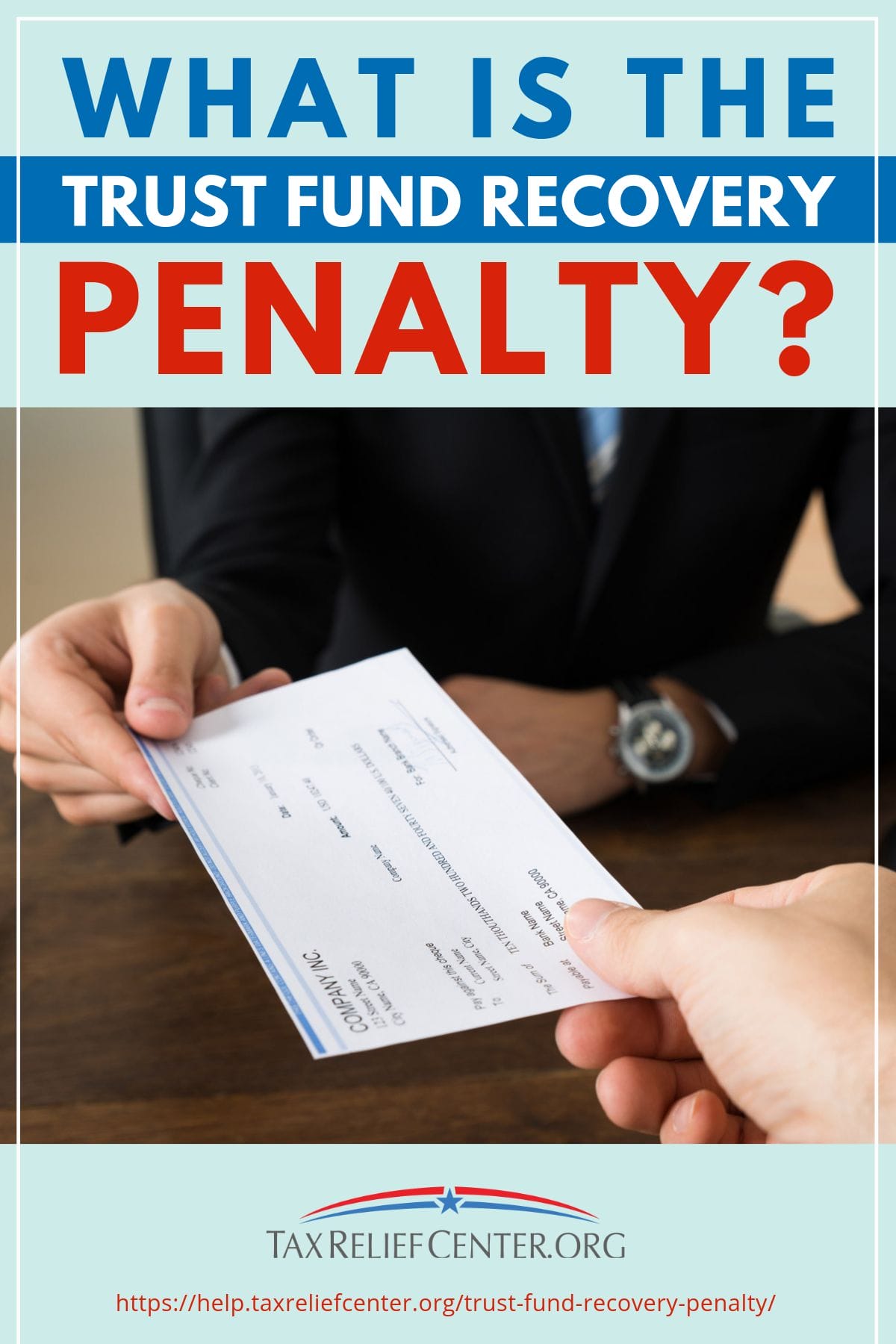Taxpayers may suddenly undergo the trust fund recovery penalty process due to no fault of their own, and understanding the process helps make it a little easier.
RELATED: How To Avoid Taxes Through The Mortgage Forgiveness Debt Relief Act
In this article:
- What Is the Trust Fund Recovery Penalty?
- How Much Is the Trust Fund Recovery Penalty?
- Who Is Responsible for the Trust Fund Recovery?
- How Does the IRS Investigate Taxpayers for TFRP?
- What Can a Taxpayer Do If the IRS Levies a TFRP?
Frequently Asked Questions About the Trust Fund Recovery Penalty (TFRP)
What Is the Trust Fund Recovery Penalty?
The IRS requires some entities to withhold taxes to promote a timely and efficient tax collection system. Rather than rely on all taxpayers to perform their respective tax filing, the government lowers the risk of non-payment and non-filing of taxes by entrusting the filing and tax collection to employers through the Trust Fund Recovery Penalty (TFRP).
The TFRP is a special tax that Congress passed under Internal Revenue Code (IRC) section 6672(a). Under this section, taxpayers, usually the employers, have to take taxes from employees or else the IRS will apply a trust fund recovery penalty.
However, the IRS treats the TFRP more as a penalty and collection method, rather than an additional source of revenue. The TFRP has a deep connection with withholding taxes, as well as taxes taken out of payroll.
If the Trust Fund Recovery process does proceed smoothly, the IRS loses not just additional revenue but also an effective deterrent to non-payment of taxes. To ensure that employers comply, the IRS has set rules on how the tax fund recovery penalty (TFRP) applies.
Do note that the TFRP can lead to quite substantial amounts, as the IRS uses the highest possible approximation of penalties. The IRS sees the TFRP as a necessity, as the numbers in the TFRP contain essential taxes that favor the common good.
How Much Is the Trust Fund Recovery Penalty?
To put it simply, the TFRP is equivalent to the whole unpaid tax amount, thus doubling the supposedly withheld tax.
What is covered by the TFRP?
- Withheld income taxes such as payroll taxes
- Social Security employee contribution
- Medicare employee contribution
- Other related tax penalties, like late fees and tax debt interest
- Possibly other tax audit penalties if the IRS decides to perform an audit
Here’s a sample scenario:
Let us say that the employer-taxpayer should have withheld income, excise, and payroll taxes amounting to $3,000. On top of the original tax debt, fees and penalties, as well as employee portion of Medicare (failure to file and failure to pay penalties almost amounting to another 50%, with interest), it reaches $2,000.
Since the withholding payroll tax caused the tax debt as well as the penalties, the TFRP is $5,000. The taxpayer now has double the tax debt.
As the tax debt reaches $10,000, the IRS may move to tax collection methods other than the usual tax notices. The IRS can garnish wages as well as submit to the court and land registrar a request for a tax levy.
Do note that the IRS will apply the highest possible calculation. Negotiating with the IRS can lead to lower amounts, but avoiding the TFRP in the first place should always be the highest priority.
Remember that the form given by the IRS, Form 4180, has very strict guidelines. Any discrepancy, even if accidental, can lead to additional clarifying forms, so it may be best for taxpayers to ask for help from professionals.
Who Is Responsible for the Trust Fund Recovery?

There are two main tests to know if someone is liable for the Trust Fund Recovery Penalty.
The first test for TFRP responsibility can be found in IRC section 6671(b). Also known as the responsible person test, the IRS states that anyone who has the duty to withhold and submit taxes can be penalized.
For more specific roles:
- The taxpayer assigned to giving out or signing checks
- The taxpayer sits on the board or handles the administration of the business, like a supervisor or officer
- He or she fills out the payroll forms, as well as sign and prepares the tax documents
- The taxpayer can hire or fire the employees
- He or she can approve or deny any changes in the budget or allocation of funds
- He or she can make decisions on paying or borrowing loans
- The taxpayer controls the payment of salaries and bonuses
- He or she is active in the day to day operations of the business
This list is not exhaustive in any way.
However, if you or someone you know believe that their wages are not properly withheld and social benefits and contributions not properly sent, then the list of roles can help you pinpoint who to ask for help, as well as who to report to the IRS.
The last test for TFRP application is the willful failure test.
In this test, the taxpayer should be found guilty of any kind of activity that shows malice or bad faith in withholding taxes. Then, the Trust Fund Recovery Penalty applies.
For example, if the employer does not classify a worker as an employee but instead as a freelancer, some income taxes, as well as FICA contributions like social security, are not remitted to the IRS.
Since the act of mislabelling an employee is willful and voluntary, the employer shows bad faith particularly for evading taxes. Due to this, the taxpayer not only pays any possible fees applied through their fraudulent acts but also the TFRP, which is the withheld taxes, penalties and the employee part of the FICA contributions.
RELATED: 9 Tax Audit Triggers To Watch Out For
How Does the IRS Investigate Taxpayers for TFRP?
Usually, when a taxpayer is under scrutiny for the trust fund recovery penalty, the IRS assigns a revenue officer from the collections department to review the tax file.
The assigned revenue officer will ask for documents first. Some of the more commonly asked for items include canceled checks, payslips, job contracts, workload scheduling, and even bank statements.
If the revenue officer encounters difficulty with the process, the taxpayer may use the recourses given by law, like an administrative summons. The revenue officer may also interview other individuals and ask the taxpayer to fill out Form 4180.
Demand for the TFRP comes with Letter 1153. The taxpayer must then pay the penalty within 60 days of receiving the letter.
How does the IRS find taxpayers to go through the TFRP process?
Anything that can trigger an audit can trigger the TFRP process. For example, having an employee complain to the state department of labor can open not just an audit but also the possibility of the TFRP.
The IRS has data about similar cases, and with large amounts of data come patterns. The IRS has algorithms that can spot the same or similar activities that may lean toward the possibility of withheld taxes not filed. For example, employers in industries where employee misclassification is rampant, like cleaning agencies, have a higher chance of undergoing the TFRP process.
As long as the employer properly labels workers as employees and performs the responsibilities accurately, then taxpayers should not be afraid of the process.
What Can a Taxpayer Do If the IRS Levies a TFRP?
Taxpayers can ask for penalty abatement, where he or she shows that responsibility does not fall on them. For example, a manager of a business may claim penalty abatement if a more directly responsible manager who takes care of reporting taxes of an employee willfully did not submit the proper taxes.
For those who need to pay the TFRP and have financial difficulties, paying an installment plan is also possible. Of course, an offer in compromise is also available.
The trust fund recovery penalty leads to better tax collection, but may affect innocent taxpayers. By knowing more about the process, taxpayers can be safe from the lengthy process and focus on other, more productive areas of their professional and personal lives.
What are your thoughts about the Trust Fund Recovery Penalty? Have you gone through one? Let us discuss in the comments section below.
If you owe back taxes, visit taxreliefcenter.org for more information on tax relief options.
Up Next:
- Tax Penalty For Underpayment [2019 Edition] | Tax Relief Center
- What To Do If You’re Flagged For A Tax Audit
- Personal Income Tax | A Guide To Doing Your Taxes


